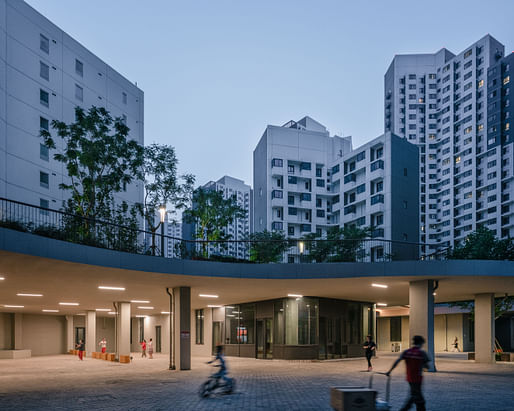
Embarking on a new project type for the first time in the history of the practice, Ma Yansong’s MAD Architects recently unveiled photos for a social housing scheme located near Beijing’s central business district called Baiziwan.
It is promoted to include some 4000 new housing units distributed through a program of 6 blocks and 12 buildings equaling a massive total construction area of 473,300 square meters (about 5.1-million-square-feet). The project’s brief asked for an eco-friendly scheme that would connect the site with the pedestrian life of the city at street level, and MAD responded with a plan anchored by a central commercial artery and connected via a blood-red walkway to a circuit of semi-open "gray" spaces, a nature sanctuary, amphitheater, and elevated park planners conceive of as a “Floating Garden.”
Two of the structures were constructed using the international passive house standard as well. In a press statement, MAD also said space restrictions played a key role in characterizing the layout of each unit.
The design team explains, “with the plot ratio of 3.5 and the height limit of 80 meters, the high density has caused many restrictions on general layout for each unit’s daylight calculation. Throughout the design process, MAD sought to ensure that every tenantable room across the project would get sufficient sunlight. The resulting scheme, therefore, adopts a Y-branch building form, with communal corridors located along the north face of each building to enhance sunlight exposure in the residential units.”
“These Y-shaped footprints combine with gradual stepping forms and staggered heights fabricates an overall “mountain” topography across the site. The interface between buildings form semi-enclosed spaces, promoting a sense of intimacy and community across the site on a human scale. From afar, the scheme’s simple white façade and undulating mountain form creates an enriching addition to the city skyline.”

Yansong says it is the product of eight years of research, incorporating the lessons on the “The Sociality of Social Housing” taken from similar examples worldwide. The history of large-scale social housing schemes in China’s capital is one that likewise reflects the country’s development agenda and political influence, growing out of socialist-inspired blocks that came with the city’s expansion in the 1960s and into a free market era characterized by the private development that Yansong claims have led to a homogenization of design and the deprioritization of low-income housing until very recently.
MAD promises that the client’s demands meant that 80% of all components used in Baiziwan's construction were prefabricated off-site. At least 3000 families have moved in thus far, with the rest expected sometime before the end of the year. Yansong promises they will be welcomed into a human-centric environment, and that he hopes the concept will provide future inspiration to designers working in the world’s largest residential market.
“Human is the aim of habitat,” the project’s description reads finally. “The notion encompasses dignity and social equity. The design concept for Baiziwan Social Housing integrates affordable housing communities with a universal ideal for dignified living. It is achieved by a simple aesthetic. Baiziwan Social Housing is an important step forwards ideal living in China.”
Are you sure you want to block this user and hide all related comments throughout the site?
No Comments
Archinect
This is your first comment on Archinect. Your comment will be visible once approved.